You have 0 product(s) in your cart.
Abyss Scuba Diving
Mastering The Surf: Your Guide To Safe Scuba Diving In The Surf Zone
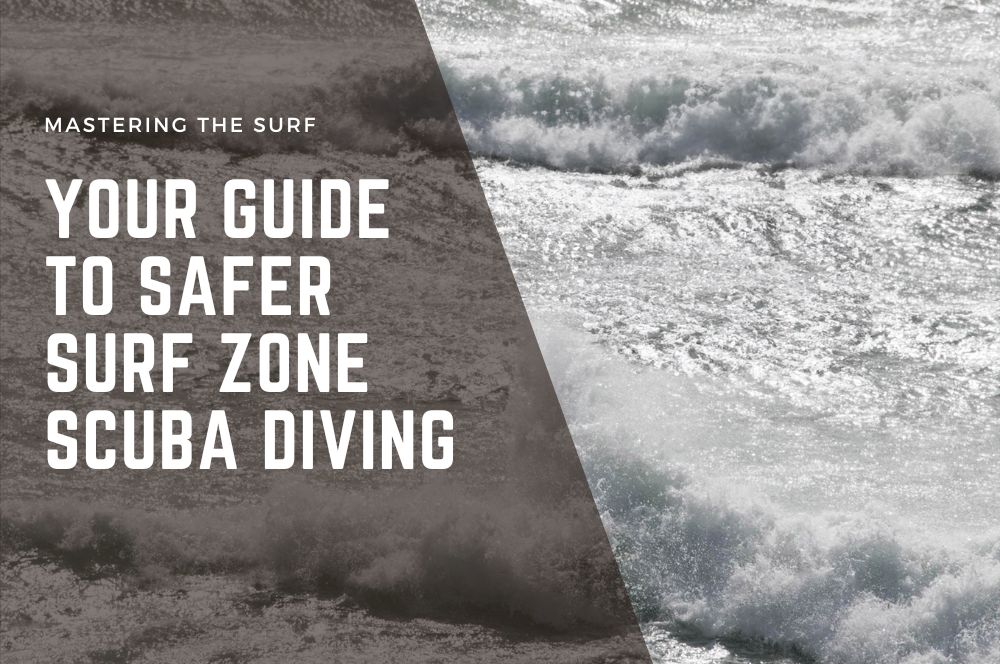
Mastering the Surf: Your Guide to Safer Surf Zone Scuba Diving
Facing the surf when scuba diving can be daunting, but knowing what to look for makes all the difference. This guide cuts straight to the heart of surf zone diving—how to read the waves for safe, enjoyable dives. Discover tips for planning, entering, and exiting the surf, and learn why surf intelligence is a diver’s best friend underwater.
Key Takeaways
-
Understanding and assessing surf conditions, tide cycles, and local topography is crucial for planning safe scuba diving excursions in surf zones.
-
Divers should be prepared to adapt their entry and exit strategies to the changing surf conditions and have the flexibility to postpone a dive if judged too risky.
-
Effective pre-dive planning, communication through established hand signals, and the appropriate modification and handling of gear are key to navigating the surf zone while scuba diving safely.
Evaluating Surf Conditions for Dive Planning

Before even touching the sand, every diver should prioritize evaluating the surf conditions as much as they do checking their gear. The ocean is a dynamic playground, where tides, currents, and the very temper of the sea dictate the safety and pleasure of your dive. Dive planning, therefore, is not just a matter of plotting a course but understanding the environment in which you’ll immerse yourself. From the tug of the tides and the dance of the currents to the warmth of the water and the unseen contours of the bottom, all contribute to a dive’s success.
Grasping the surf’s behavior is a skill of utmost importance in a diver’s skill set. Waves are not mere obstacles; they are the ocean’s language, and interpreting their patterns can reveal potential hazards like rip currents or hidden rocks. Surf conditions hold sway over every aspect of scuba diving, influencing everything from the ease of water entry and exit to the tranquility or turbulence you’ll encounter beneath the waves. As guardians of our own safety and enjoyment, we must learn to read the sea’s signals and respond with wisdom.
Understanding Surf Reports
Before donning their gear, smart divers consult surf reports for trusted insights. These forecasts are a treasure trove of data, with insights into wave height, swell direction, and the all-important wave period. But what do these numbers and terms mean for your dive? Wave height, measured in feet or meters, gives the first clue to the conditions you’ll face at the dive site. It’s a simple equation: The higher the waves, the more skillful and careful your entry and exit must be.
Swell direction, the compass from which waves approach, can set the stage for a smooth dive or signal a need for caution. A swell rolling in from the open ocean might suggest rougher conditions, while a sheltered cove could offer more protection. Wind, the sculptor of waves, also plays its part. Offshore breezes can flatten the sea’s surface, creating conditions that are more forgiving for divers. In contrast, onshore winds can whip up the surf, staging a challenging scenario for your entry and exit maneuvers.
However, a surf report is just a starting point. For a comprehensive understanding of your dive site’s conditions, it is advisable to complement these forecasts with local insights from seasoned divers and dive operators well-acquainted with the area. They’ll tell you how the swell interacts with the local topography, which could mean the difference between a serene dive and a struggle against the waves. And let’s not forget the tide cycle, a rhythmic force that can turn a dive site from accessible to off-limits in a matter of hours. Avoiding strong tidal currents while planning your dive isn’t just a smart move – it’s absolutely necessary.
Visual Assessment Techniques
An experienced eye can unlock the secrets of the surf zone with a careful, patient gaze from the shore. This visual evaluation isn’t mere speculation, but rather a honed skill. Look for calm patches or channels that weave between the waves – these are the water’s invitations, signaling a safer approach to the dive site. Yet, the ocean also lays traps: rip currents and submerged rocks disrupt the regular rhythm of the waves, hinting at hidden dangers waiting to ensnare the unwary diver.
To refine your visual assessment, seek counsel from those who have come before. Seasoned divers carry a mental map of the underwater terrain, informed by countless entries and exits through the surf. Their advice can illuminate the path ahead, helping to anticipate and navigate the challenges that lie beneath the breakers.
As you stand on the threshold of the surf, remember: the waves are the pages of an open book, and learning to read them is a chapter in every diver’s education.
When to Postpone a Dive
Nonetheless, there are times when the cues from the sea appear more like a cautionary tale than a call to dive. When the surf roars louder than your desire to dive, it may be time to step back and honor the ocean’s power. High surf conditions, with their formidable waves and concealed perils, can transform a dive from a joy to a jeopardy,. Diver safety is not just a matter of protocol; it is the bedrock upon which all good dive experiences are built.
Choosing to delay a dive is not a sign of failure, but rather a demonstration of prudence and reverence for the sea. By choosing to dive another day, you preserve not only the potential for future adventures but also the well-being of yourself and your dive buddies. So, when the surf sets a stage too tumultuous for a safe performance, take a bow and exit gracefully, knowing that the ocean waits for those patient enough to wait for her calm.
Adapting Your Dive Plan to Surf Conditions
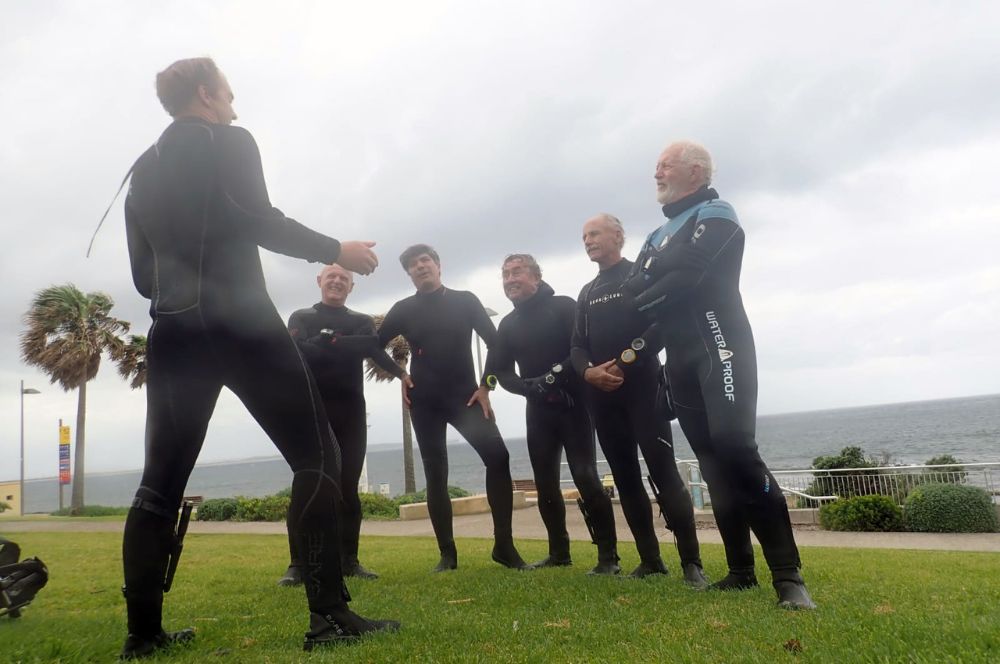
Once you’ve got a grasp on the surf conditions, the next step is to adjust accordingly. The sea is ever-changing, and so too must be our dive plans. Rough waves serve as a reminder that flexibility is as important as any piece of scuba gear when it comes to diving. The readiness to change plans when faced with perilous surf conditions isn’t just a recommended practice—it’s vital for ensuring diver safety and enjoyment,. This adaptability is a hallmark of experienced divers, who know that the conditions dictated by surf can dramatically impact the outcome of a dive.
Whether it’s selecting an alternative dive site or adjusting your entry and exit strategies, the key lies in recognizing and responding to the challenges presented by the surf zone. In the face of capricious waves, a diver’s wisdom and willingness to adapt are their true north. Let’s explore how to make these critical adjustments, ensuring that each dive is a testament to your skill and foresight.
Choosing an Alternative Site
Sometimes the surf tells a tale of caution, urging divers to consider an alternative stage for their underwater ballet. When the primary dive site’s waves are more daunting than inviting, wisdom lies in selecting a backup location. Alternative sites, with their promise of safer entry and exit points, become havens in the face of the ocean’s might. Entry and exit points are the diver’s lifeline, the beginning and end of their journey, and choosing the right ones is a matter of utmost safety.
During this decision-making process, it’s important to identify potential risks, which can differ from one dive site to another. The strength of the surf can change, not just over the course of a day but from one hour to the next. Thus, a flexible diver is one equipped with a plan B: a sheltered cove, a dock, or a set of stairs that offer a more gentle introduction to the underwater world. After all, the goal is to dive safely, not to conquer the surf – and choosing the right site is a strategic move in this aquatic chess game.
Adjusting Entry and Exit Strategies
With the right site chosen, the next step is to tailor your entry and exit strategies to match the surf’s cadence. The ocean’s rhythm can be unpredictable; mastering how to move in harmony with it, instead of resisting it, can be a game-changer. For instance, in taller waves, a diver might deflate their BCD to reduce buoyancy and avoid being tossed about. Conversely, in smaller waves, walking in might suffice. It’s about choosing the technique that aligns with the surf’s tempo, whether it’s the confident stride of the Giant Stride, the roll of the Back Roll, or the seated ease of the Seated Entry.
In heavier surf, divers must become one with the ocean, using techniques such as walking sideways into the waves to reduce impact or pulling oneself along the seabed to reach deeper waters. Exiting requires equal finesse, facing the incoming waves with a high step to prevent being toppled by the surf’s force. It’s about leveraging the waves to aid your journey back to the beach, and only removing fins when the water is shallow enough to comfortably crawl the remaining distance to solid ground.
Timing Your Dive with Tide and Surf
In terms of navigating the surf zone, timing is of paramount importance. The ebb and flow of the tides can transform the depth and accessibility of a dive site, making the difference between a dive that’s a delight and one that’s a struggle. Weather patterns and tidal variations are the diver’s almanac, guiding them to the most opportune moments to slip beneath the waves. Observing the surf for a spell before taking the plunge can reveal windows of calmer conditions, granting safer passage into Neptune’s realm.
In the dance with the tides, patience is a virtue. Waiting for the ocean to reveal its quieter moments allows divers to enter and exit the water with grace and assurance. This harmony with the natural cycles is a lesson in respect – for the ocean and for the safety of all who dive within it. The wise diver knows: to become one with the sea, one must first listen to its rhythm.
Communication Strategies in Rough Surf
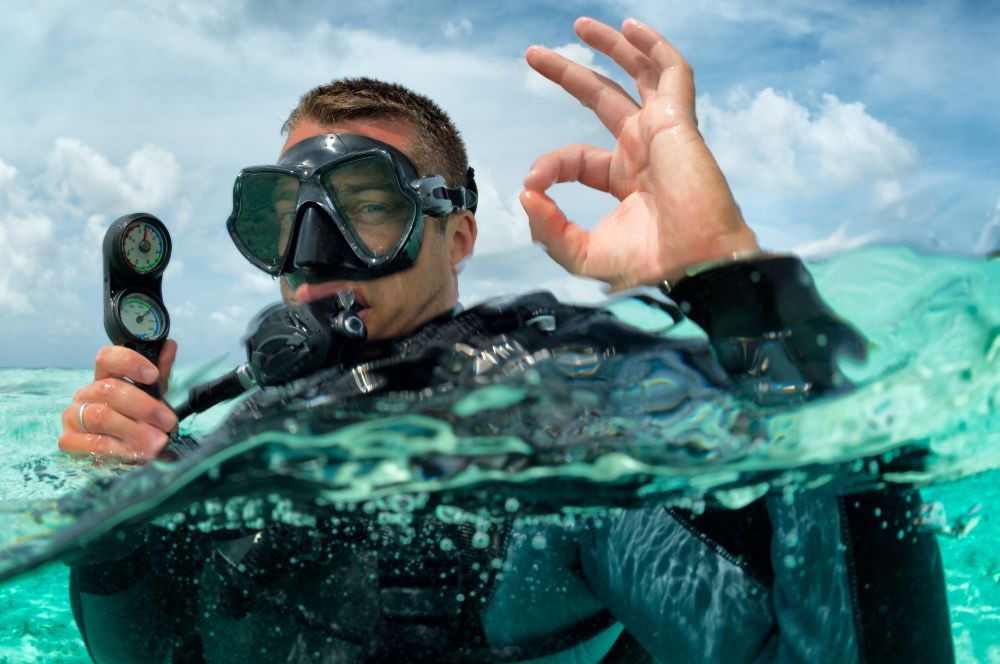
In situations where waves are crashing and winds are howling, communication between divers becomes a vital lifeline. The rough surf, with its cacophony and chaos, can create barriers to clear messages between those on the surface and those exploring the depths. It’s in these tumultuous conditions that the importance of communication strategies becomes crystal clear. To ensure safety and coordination among divers, let’s delve into the art of communication in the face of the surf’s roar.
The goal is to establish a dialogue that transcends the noise and confusion of the surf zone. Through meticulous preparation, signaling devices, and clear underwater hand signals, divers can create a network of communication as reliable as any on terra firma. The sea’s tumult demands a robust response, and it is within our power to answer that call.
Pre-Dive Briefing Essentials
Consider the pre-dive briefing as the introduction to every underwater adventure. It’s where divers come together to establish a shared language of hand signals, understand the roles of each dive leader, and lay out the safety protocols that will guide their journey. Such preparation forms the bedrock for conducting safe and successful dives. It’s a time for the dive guide to shine, outlining how they’ll signal divers underwater in an emergency and ensuring that every participant knows their role in the aquatic ballet.
During this briefing, the intricacies of the dive are unveiled. This includes:
-
Boat entry and exit procedures
-
Navigation of the dive site
-
Air monitoring
-
The buddy system
It’s a time for clarity and questions, for ensuring that all divers are in sync and ready to support one another. This comprehensive approach to the pre-dive briefing isn’t just a good idea—it’s a lifeline that weaves through the dive, ensuring every participant is informed, confident, and prepared for the experience ahead.
Surface Communication Tactics
After the briefing sets the context, the focus shifts to surface communication tactics. In the heave and ho of choppy waters, divers employ a symphony of signals to remain connected. Bright-colored inflatable buoys and whistles become extensions of the diver’s voice, cutting through the din of the surf. These devices aren’t just add-ons; they’re crucial tools that enhance a diver’s visibility and ensure their support team can locate them, even if they’re out of sight.
Auditory signals like whistles or Dive Alert Plus devices are invaluable for catching the attention of boat crews, especially important in areas bustling with boat traffic. In dire situations, where divers are beyond visual or auditory range, technologies like the Nautilus Lifeline GPS device can be the difference between a timely rescue and a dire outcome, pinpointing a diver’s exact location to nearby vessels.
Underwater Hand Signals Review
Clear and confident communication doesn’t end at the water’s edge. Once submerged, divers must rely on the universal language of hand signals to converse with their fellow adventurers. These signals must be performed with precision and certainty, gestured strongly in front of the chest where they cannot be missed, even in conditions of low visibility. It is this standardization of signals that ensures every diver, regardless of their home waters, can understand and be understood beneath the waves.
But when the surf churns up sediment and visibility drops, divers have another card up their wetsuit sleeve: the underwater writing slate. This simple tool allows for more complex messages to be shared when hand signals just won’t cut it. It’s a testament to the resourcefulness of divers and their commitment to safety and teamwork, no matter what the ocean throws their way.
Essential Gear Modifications for Surf Zone Diving
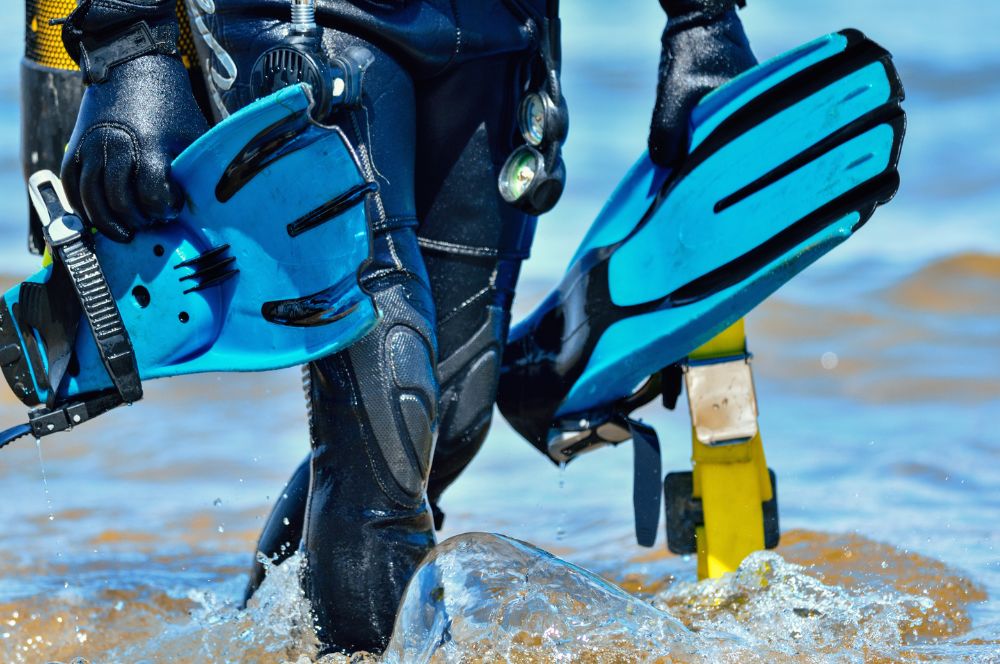
The surf zone can be relentless, requiring more from a diver’s equipment compared to the serene depths of a calm sea. It’s here that gear modifications become not just beneficial but essential. From fin straps that must withstand the pull of the waves to exposure suits that guard against the scrape of the sand, each piece of gear must be honed to perfection,. These are the tweaks and reinforcements that shore up a diver’s confidence, allowing them to meet the surf’s challenge head-on.
By taking the time to modify and strengthen gear, divers can reduce the risk of equipment failure when it matters most. This section will guide you through the essential gear modifications that can make the difference between a dive that’s memorable for the right reasons and one that’s memorable for all the wrong ones.
Reinforcing Dive Gear for Surf
In the chaos of the surf, equipment can endure a lot of wear and tear. To prevent the loss of crucial equipment like fins, divers can reinforce their fin straps with stronger materials or secondary securing methods. A simple inner tube material, when wrapped around the heel strap, can provide a robust reinforcement that will endure the ocean’s tug,. Wetsuit cement, applied after cleaning the straps with acetone to ensure a strong bond, can further secure these modifications against the relentless surf.
These straightforward yet efficient modifications are a diver’s acknowledgment of the old saying: “An ounce of prevention is worth a pound of cure.” By reinforcing gear for the surf zone and taking measures to avoid decompression sickness, divers can focus on the beauty of the dive, rather than the fear of losing their equipment to the ocean’s depths.
Selecting Appropriate Exposure Suits
The right exposure suit is a diver’s second skin, offering protection not just from the cold but from the abrasive embrace of the surf. Selecting an exposure suit for surf zone diving is a balance between thickness for warmth and durability for protection. In colder waters, a 7 mm suit with a hooded vest might be required, while warmer waters might call for a more flexible 3 mm suit.
The fit of an exposure suit is paramount, as good seals at the wrists, ankles, and neck are what keep a diver warm and protected from the flushing of water that can occur in the surf zone. While surfing wetsuits may offer more flexibility and range of motion, they may not provide the same level of warmth as a diving-specific suit, but can be a suitable alternative if financial constraints are a consideration.
Carrying Additional Safety Equipment
Apart from the standard scuba equipment, diving in the surf zone necessitates carrying extra safety gear. An emergency air system, such as a pony bottle or a spare air supply, can make a significant difference in an out-of-air emergency, offering the diver a safe ascent back to the surface. It’s about having options and backups, ensuring that you’re prepared for the unexpected.
Monitoring your air consumption is also critical, and this is where a submersible pressure gauge attached to each cylinder comes into play. These gauges allow divers to keep a vigilant eye on their remaining air, ensuring that they have enough inert gas to complete their dive and handle any potential issues that may arise.
In a dynamic environment like the surf zone, being equipped with the right safety equipment is not just for your own safety—it’s a courtesy to your dive buddies, who rely on you to be as prepared as they are. Consult with a scuba instructor to ensure you have the necessary gear for such conditions.
Techniques for Navigating the Surf Zone
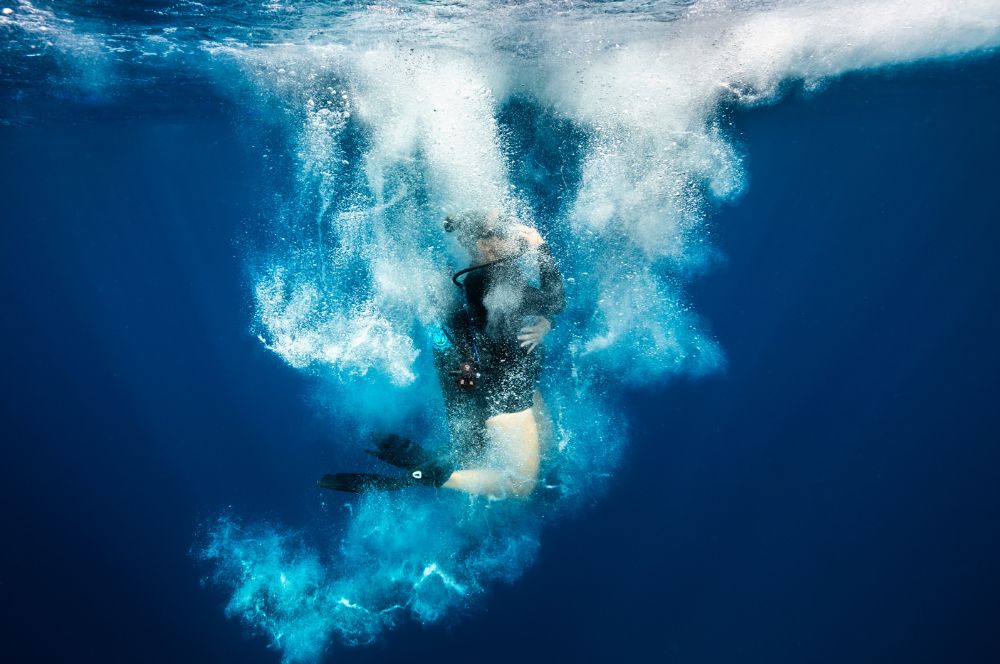
Navigating the surf zone is much like a dance, demanding elegance, timing, and a grasp of the ocean’s rhythm. Whether you’re entering the frothy threshold or making your exit, each move should be deliberate and measured. The strategies for navigating the surf zone aren’t solely about moving from one point to another; they’re about doing so with minimal resistance and maximum safety.
In this section, we’ll explore the steps of this dance, from the careful approach of entering the surf to the strategic retreat of exiting back onto the shore. With practice, these techniques can become second nature, allowing divers to traverse the surf zone with confidence and poise.
Entering the Surf Zone
The secret to a successful entry into the surf zone hinges on adapting to the waves’ conditions. Observing and timing your movements to coincide with the lulls between waves is crucial; it’s about seizing the moment when the ocean takes a breath and allows safe passage. In extreme conditions, divers must be equipped not only with their fins but also with the know-how to deflate their BCD, remain close to the bottom, and surface only when the calmer waters are reached.
In gentler surf, the approach can be less combative. Divers, including those practicing solo diving, may walk backwards into the water, don their fins at a comfortable depth, and then swim out until it’s safe to descend. It’s a measured, methodical process that respects the ocean’s power while asserting the diver’s presence. No matter the method, the goal is the same: to enter the underwater world with the least amount of drama and the greatest amount of control.
Exiting the Surf Zone
Exiting the surf zone can pose as great a challenge as entering it, if not greater. The return to shore is often against the push of the waves, requiring divers to use the ocean’s energy to their advantage. This is where the technique of backpedaling with fins on proves its worth, maintaining stability until it’s shallow enough to stand and walk out. It’s about staying in tune with the waves, using their force to propel you forward while maintaining a steady course toward your exit point.
By maintaining negative buoyancy and timing your ascent with the waves, you can navigate out of the surf zone safely and efficiently. It’s about knowing when to ride the wave and when to dive beneath it, leveraging the ocean’s power to facilitate your exit. With practice, the exit becomes less of an ordeal and more of a final act in the day’s dive adventure.
Managing Buoyancy and Visibility Challenges
The surf zone poses more than mere physical obstacles; it also introduces challenges to a diver’s buoyancy and visibility. The turbulence and chop on the surface can disrupt a diver’s ability to maintain buoyancy control, a critical skill for any diver. It’s a test of a diver’s ability to adjust on the fly, to find stability in the unstable, and to maintain their depth despite the ocean’s erratic push and pull.
Visibility, too, can be compromised in the surf zone, as the water’s refractive index can distort the size and distance of objects underwater. This distortion requires divers to rely even more heavily on their navigation skills and their understanding of the underwater environment. It’s about staying oriented, staying in control, and using the natural features of the bottom to guide your path through the underwater landscape.
Advanced Considerations for Technical Divers
For those who stretch the limits of recreational diving, the surf zone introduces a distinct set of challenges. Technical divers, with their sights set on depths that can reach up to 120 meters, must consider how to manage their specialized gear in the unpredictable surf. This is diving at its most demanding, where the depth and complexity of the scuba dives require precision, planning, and a deep respect for the ocean’s power.
In this section, we’ll discuss the factors that technical divers must consider when planning and executing dives that push the envelope of what’s possible. From gear configuration to decompression planning, these are the advanced skills that distinguish the technical diver from their recreational divers counterparts.
Handling Technical Gear in the Surf
Technical diving gear must be robust enough to endure the harsh demands of the surf zone. It’s about having a setup that’s not only reliable but also adaptable to the conditions at hand. Backmount configurations, for example, provide a level of comfort and ease of transition that is particularly beneficial in the dynamic environment of the surf. The recommended backmount doubles offer a more streamlined approach to gear handling, especially when it comes to shore diving where the surf can be a significant obstacle.
Ensuring quick accessibility to critical components of your diving gear is paramount in surf conditions. Technical diving is about being prepared for any eventuality, and in the surf zone, this means having a gear setup that allows for rapid response to any situation that may arise. It’s about being ready, being agile, and being able to handle your technical gear with confidence, no matter what the ocean throws your way.
Decompression Planning in Surf Environments
Decompression planning is a crucial facet of technical diving, especially in the unpredictable environment of the surf. Early technical divers relied on pre-generated tables for fixed decompression stops, but today’s divers have access to dive computers that provide dynamic planning capabilities. These tools allow for the customization of decompression models and personal conservatism settings, enabling divers to plan their dives with a level of precision that matches the complexity of their undertakings and helps prevent decompression sickness.
However, even with the most advanced technology, divers must be proficient in the use of their computers and have a clear understanding of their decompression obligations. Planning is now a two-part process: relying on the dynamic plan from the dive computer, with written plans serving as secondary backups. Minimum gas calculations are a cornerstone of safe technical diving, ensuring divers have enough gas to surface or reach the next gas source, a consideration that becomes all the more important in the surf’s shifting landscape. It’s about being prepared, being knowledgeable, and being able to adapt your decompression plan to the conditions at hand, ensuring a safe ascent back to the surface.
Summary
As our journey through the surf zone comes to a close, we reflect on the lessons learned and the skills honed. We’ve navigated the challenges of surf conditions, learned the art of adapting our dive plans, and mastered the vital communication tactics needed in the turbulent waters. We’ve reinforced our gear, selected the right exposure suits, and ensured we carry the additional equipment that can make all the difference. We’ve danced the delicate dance of entering and exiting the surf zone and managed the buoyancy and visibility challenges that come with it. For the technical divers among us, we’ve delved into the intricacies of gear handling and decompression planning in an environment that demands our utmost attention and respect.
Let this guide be a beacon as you venture forth into the surf, a reminder that with preparation, knowledge, and adaptability, you can transform the ocean’s challenges into your triumphs. Diving in the surf zone is a testament to the diver’s spirit, a blend of adventure and prudence that allows us to explore the depths while safeguarding our return to the surface. May your dives be as fulfilling as they are safe, and may the surf be ever in your favour.
Frequently Asked Questions
Can beginners scuba dive?
Yes, beginners can scuba dive safely with proper training, equipment, and adherence to safety protocols.
How is scuba diving in Australia?
Scuba diving in Australia offers outstanding water clarity, vibrant coral reefs, and a diverse range of marine life, including sharks, Manta Rays, and turtles. The Great Barrier Reef and other locations provide exceptional opportunities for underwater exploration.
What is called scuba diving?
Scuba diving is the act of swimming underwater while using a self-contained breathing apparatus, allowing divers to explore underwater environments and observe marine life. It stands for "Self-Contained Underwater Breathing Apparatus."
Can a non swimmer do scuba diving?
Yes, a non-swimmer can technically do scuba diving with the help of scuba gear such as fins and a buoyancy control device, but it comes with some limitations and challenges. Therefore, it's important for non-swimmers to be aware of the potential risks and limitations before engaging in scuba diving.
What should I do if the surf conditions at my planned dive site are too rough?
Prioritize your safety and consider postponing your dive or choosing an alternative site with safer entry and exit points if the surf conditions are too rough. Adapt your plans to the current conditions and avoid unnecessary risks.
RELATED POSTS
-
Sydney Diving Guide: Maximize Visibility…
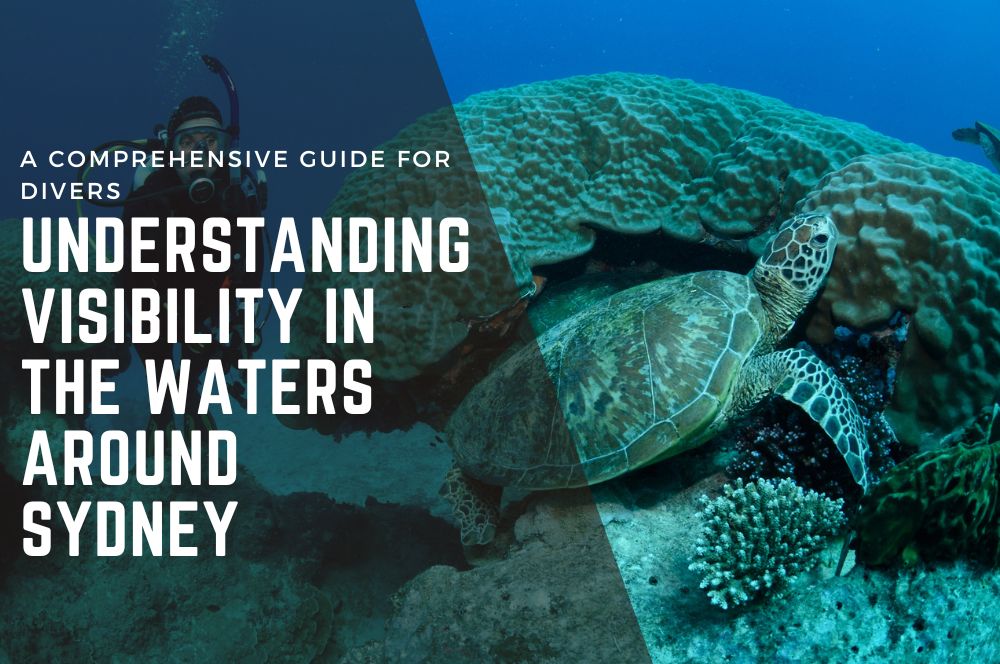
Sydney Diving Guide:…
Understanding Visibility in the Waters Around Sydney: A Comprehensive Guide for Divers Deetermine when the […] -
Sydney Diving Guide: Mastering Tides…
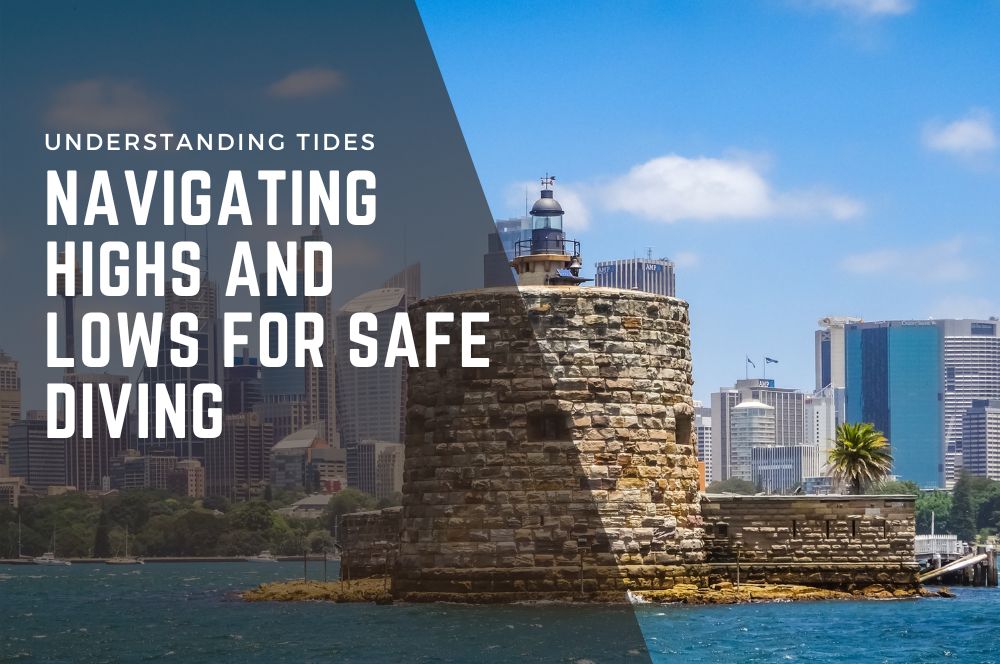
Sydney Diving Guide:…
Understanding Tides: Navigating Highs and Lows for Safe Diving Understanding ‘tide tides’ is […] -
Plunge into Scuba Diving: Pro Tips…

Plunge into Scuba Diving:…
Plunge into Scuba Diving: Pro Tips for a Thrilling Undersea Adventures Submerge into an exhilarating world […] -
The Ultimate Australian Diving Bucket…

The Ultimate Australian…
The Ultimate Australian Diving Bucket List: Exploring Underwater Treasures from Coral Havens to Sunken Relics […]
Recent Posts






